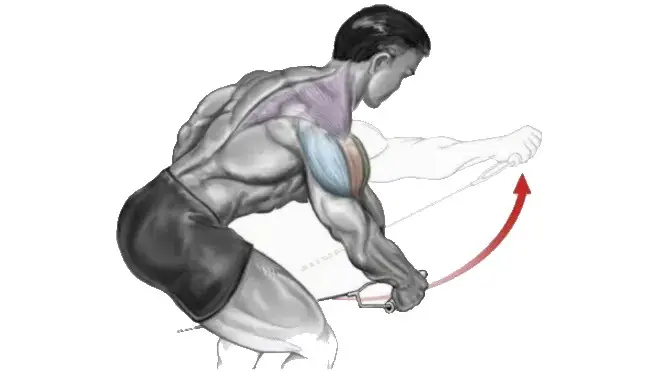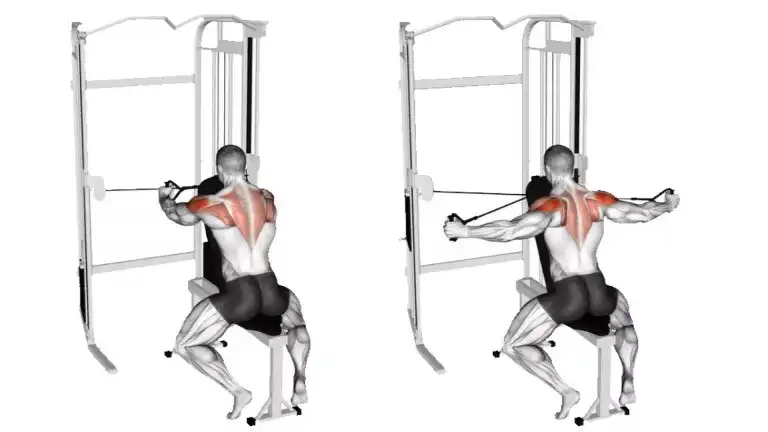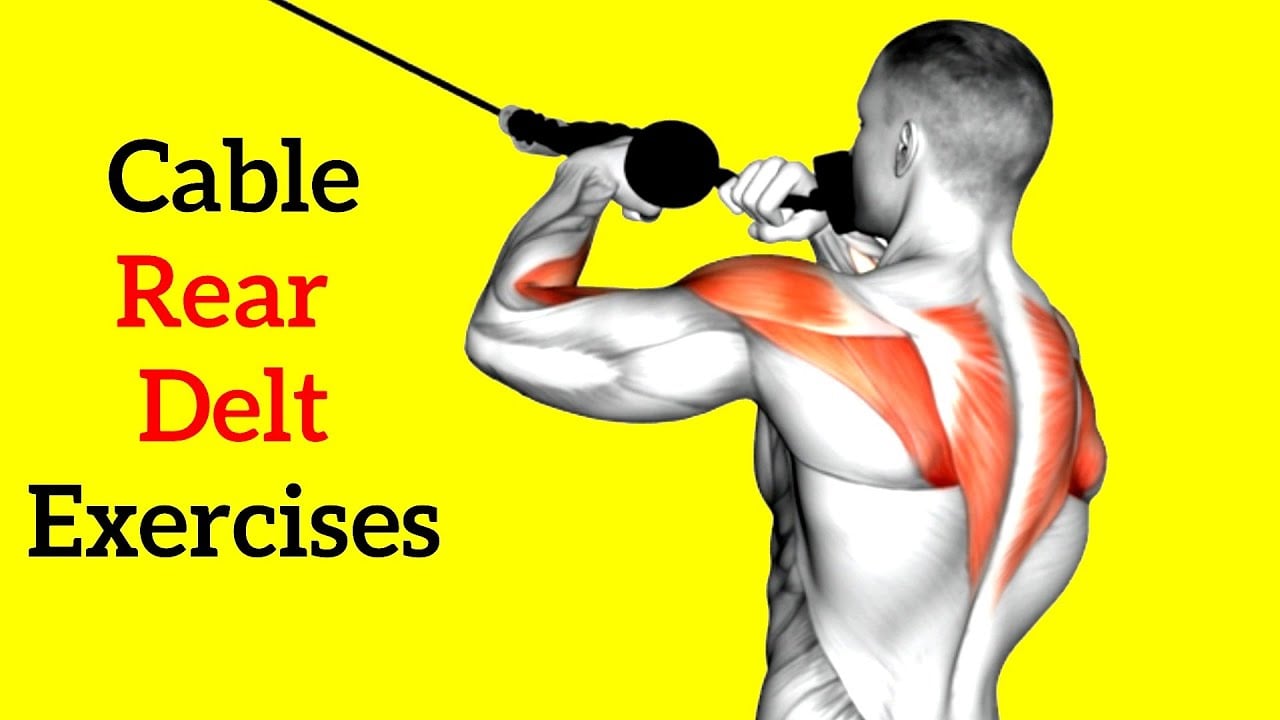As a trainer, I see many clients struggle with rounded shoulders and the nagging feeling of weakness between their shoulder blades.
The culprit? Underdeveloped rear delts.
Rear deltoids are often overlooked in shoulder workouts, but they are important for maintaining good posture and preventing injuries.
Cable rear delt exercises are a great way to improve posture and strengthen the rear deltoid. They provide constant tension throughout the movement.
This exercise works the small muscles of the rear deltoid through a full range.
Let’s learn about the 12 best rear delt cable exercises, how to do them, and pro tips.

- 12 Best Rear Delt Exercises With Cable
- 1. Bent Over Cable Lateral Raise
- 2. Cable Rear Delt Row
- 3. Standing Cable Rear Delt Row
- 4. Cable High Row
- 5. Lying Reverse Fly
- 6. Cable Machine Y Raise
- 7. Cable Twisting Standing Row
- 8. One-Arm Bent-Over Cable Raise
- 9. Cable Rear Drive
- 10. Reverse Cable Crossover
- 11. Face Pull
- 12. Incline Bench Cable Rear Delt fly
- How to Train Your Rear Deltoid With Cable
- 1. Train the rear deltoid with a back workout
- 2. Train Rear Delts Twice per week
- 3. Prioritize Rear Delts On Shoulder Day Among The Three Delt Heads
- 4. Choose A Solid Mass-Builder With Challenging Weights
- 5. Sets and Reps for Delt Exercises
- 6. Beginner Rear Delt Cable Workout Plan
- 7. Rear Delt With Cable Back Workout Routine
- Conclusion
- References
- 6 Best Rear Delt Cable Exercises
12 Best Rear Delt Exercises With Cable
Are you ready to build a powerful and well-defined rear delt? To do so, you must pick the right exercises for the rear deltoid and execute them to maximize its activation.
These 12 cable exercises will help you build rear delt muscles and improve posture.
1. Bent Over Cable Lateral Raise
If you’re looking for straightforward cable machine rear delt exercises to add to your workout routine, the bent-over cable raise is a great staple exercise to get you started.
It is an excellent exercise for training and isolating the rear deltoid muscle, as it provides constant stress on the muscles.
Unlike dumbbell raises, where the resistance varies during the lift, the cable pulley affords a uniform resistance throughout the motion.
In addition, studies have shown that the posterior deltoid was more activated during the bent-over lateral raise and reverse fly exercises.

How To Do
- Grab the handles attached to two low pulleys (left-side handle in right hand, right-side handle in left hand)
- Stand in the middle, then bend forward at the waist with the back straight and parallel to the floor.
- Raise your hands upward in an arc to shoulder level so the cables cross over.
- Lower the handles back down to the start position, your right hand directly in front of the left ankle and your left hand in front of the right ankle.
Tips
- Pull slowly so that you are always controlling the weight.
- You should keep your elbow slightly bent.
- If you are a beginner, start with light weights to improve your form and slowly increase the weight.
2. Cable Rear Delt Row
When you do the cable rear delt row, ensure your elbows are not dropping.
If your elbows drop, your latissimus dorsi muscles may engage more, making the exercise more like a standard wide-grip cable row.
Since you’re working your rear deltoid and not your latissimus dorsi, use a lighter weight than you would with the wide-grip cable row.

How To Do
- Sit in front of the cable machine and grasp the long bar with a pronated (overhand) grip wider than shoulder width.
- Lean back so that your torso is upright and your back is straight.
- Your arms are extended in front of you.
- Pull the bar towards your upper chest and keep your arms parallel to your body.
- Keep your elbows at shoulder height.
- Slowly return the bar to the starting position.
Tips
- Do not use your biceps to do the work. Focus on targeting the rear delts; the arms should only act as hooks.
- Do not pull the bar too high (above your upper chest). It may cause shoulder injury.
3. Standing Cable Rear Delt Row
The standing cable rear delt row with rope is a very effective and functional exercise for building muscle and strength in the upper back.
It primarily targets the rear deltoids. This movement also hits the traps, rhomboids, and biceps.
It is usually performed for moderate to high reps, at least 8–12 reps per set, as part of an upper-body or shoulder-focused workout.

How To Do
- Attach a double-grip rope to a cable pulley about mid-chest level.
- Grasp one end of the rope in each hand and step backward until the rope is pulled taut and your arms and shoulders are stretched forward.
- Keep your lower back upright and keep your knees slightly bent.
- Exhale as you pull the rope towards your shoulders until your elbows travel past your back.
- Slowly return the rope to the starting position.
Tips
- Retract your shoulder blades to keep your rear delts engaged during the exercise.
- It is a rear delt-focused exercise, not a face pull exercise, so pull the rope toward the upper chest rather than toward the face.
- Maintaining the right posture while working out is essential.
4. Cable High Row
Half-kneeling high cable rowing rope is a tremendous exercise that effectively works many muscles, including the shoulder, wing, and trapezius muscles.
In addition, it is one of the most effective corrective exercises for compensating for poor posture and shoulder dysfunction.

How To Do Cable High Row
- Set the cable up at a high point with the rope attachments
- Grab the rope with both hands using an overhand grip
- Then, take a step back and get onto your knees.
- Starting with your arms stretched out and away, pull back through your elbows until your hands are just in front of your shoulders.
- Slowly return to the starting position.
Tips
- Don’t lean backward to pull the weight towards you.
- Focus on the mind-muscle connection to pull down by using your back muscles.
5. Lying Reverse Fly
The lying cable rear delt fly is a great option if you have any lower back issues or just want to reduce the amount of stress on your lower back.
You are doing this exercise in a supine position, which allows you to focus purely on contracting your rear delts to pull the cables down to the sides.

How To Do
- Position a flat bench between two high pulleys.
- Lie supine (on your back), holding the pulleys’ handles.
- The handle from the right pulley should be in your left hand, and the handle from the left pulley should be in your right hand. The cables should be crossed and pulled tightly.
- Exhale as you pull your arms open and out to the sides.
- Hold for a count of two. Inhale as you slowly return to the starting position.
Tips
- When lying down, ensure your shoulders are lined up with the pulleys. This will ensure optimal mechanical leverage.
- Keep the movement slow and deliberate.
6. Cable Machine Y Raise
The cable Y-raise is a great exercise for your deltoid muscle. It works all three parts of the muscle: the front, back, and sides.
This exercise combines horizontal shoulder abduction with external shoulder rotation. It’s strengthening the external shoulder rotators and the internal shoulder rotators.

How To Do
- Stand between two low cable pulleys and hold the cable handle on the opposite pulley.
- Maintain good posture by pushing your chest forward and pulling your shoulders back.
- Raise your arms upwards and outwards, forming the letter ‘Y’ with your whole body.
- Hold for a second, and then slowly lower the weight back to the starting position.
Tips
- Maintain a fixed, slightly bent elbow position throughout the exercise.
- Keep your torso still and your back straight.
- Don’t just swing your arms.
7. Cable Twisting Standing Row
It involves numerous muscles, requiring you to rotate your waist slightly. This is a unilateral exercise, so you must engage your core throughout the movement.
Besides being a great back and shoulder exercise, this movement also works your hips, glutes, and other lower body muscles.

How To Do
- Attach a single grip handle to an elbow-high cable pulley.
- Step back and get into a staggered stance, knees slightly bent.
- Your arm should be out straight, and your waist should be rotated towards the cable.
- Keep your elbow close to your body and rotate your waist in the same direction as you pull back towards your waist.
- Pause briefly at the movement’s top, then slowly return to the starting position.
- Do 8–10 reps on each side and 3–4 sets
Tips
- You can place your inactive hand on your other hip for added stability.
- To get the most out of this exercise, do it slowly and carefully.
8. One-Arm Bent-Over Cable Raise
You can do this exercise with one arm at a time, allowing you to adjust the range of motion by adjusting the start or finish position.
This unilateral version allows you to raise your hand higher and get a longer stretch at the bottom, thereby generating more work for the posterior deltoid.

How To Do
- Lean forward at the hips, place your right hand on your thigh,
- Hold a dumbbell in your left hand with your arm extended straight down.
- Raise the weight straight out to the side until your arm is parallel with the floor.
- Pause momentarily at the top of the motion before slowly lowering the weight back down to the starting position.
- Repeat with the right arm.
Tips
- Pull slowly so that you are controlling the weight at all times.
- Bent properly so that stimulation goes to the rear delt instead of the lateral delt.
- Stabilize your torso by resting your free hand on your thigh.
9. Cable Rear Drive
The cable rear drive is an exercise that builds muscle and strength in both the triceps and rear deltoids.
This is a very unconventional movement, but that doesn’t diminish its effectiveness. It’s like doing two exercises at once that work different muscles.
When you go heavy with the cable rear drive, numerous muscles in your legs and core are significantly activated to stabilize your body.

How To Do
- You should attach a rope to a shoulder-height cable pulley.
- Then, stand, so the left side of your body faces the cable pulley and grab the rope with your right hand.
- Now, take one step to the right, so there’s tension in the cable.
- Then, pull your elbow back and away from the pulley so it’s facing in the opposite direction.
- Now, extend your forearm to the right, so your arm is straight while contracting your Tricep.
- Exhale during this portion of the exercise.
- Slowly bring your forearm back and allow your arm to return to the starting position.
- Inhale during this portion of the exercise.
Tips
- It’s best to use light to moderate weights for this exercise to minimize joint stress and to maintain good form.
- Keep your body still. Only your arm should move.
- Keep your upper arm horizontal. If your elbow drops, your latissimus dorsi will get involved.
10. Reverse Cable Crossover
If you’re looking for a way to get more creative with your rear delt cable workout, why not try Reverse Cable Crossover?
To target the posterior deltoid, your arms should move directly back (and downward slightly), almost parallel to the floor.
If the hands are raised through a higher arc to a point above shoulder level, the trapezius, and lateral deltoid make a bigger contribution to the movement.

How To Do
- Stand in the center of a cable crossover apparatus.
- Start with hands crossed in front of you at shoulder height, with the left high cable in your right hand and the right in your left hand.
- Pull your elbows out and back as far as possible using your rear delts, then slowly return to the starting position.
Tips
- The posterior deltoid is best targeted with your torso upright, not leaning too far forward or back.
- Keep a controlled motion and avoid jerky movements.
11. Face Pull
Face pull is a cable machine exercise that primarily targets the rear deltoid and to a lesser degree also targets the biceps, triceps, and traps.
Use a cable pulley machine to pull the weight straight toward your forehead.
This exercise prevents muscular imbalance and builds overall shoulder strength.

How To
- Grab the ends of the rope attachment using a neutral grip (palms facing each other) and slightly lean back.
- Pull the rope toward your face as you spread the ends of the rope so they end up on the sides of your ears just above your shoulders in the finish position.
- Hold this position for as a second as you squeeze your shoulder blades together, contracting rear delts.
- Then, slowly return the rope to the start position and repeat for reps.
Tips
- Stand straight with your feet in a comfortable, balanced stance.
- Think about trying to pinch your shoulder blades as tight as possible when pulling weight toward your face.
12. Incline Bench Cable Rear Delt fly
Finally, if you’re looking for one more effective cable rear delt exercise, try the Incline Bench Cable Rear Delt fly.
It is an upper-body exercise that targets the rear deltoids and the postural muscles of the upper back.
The incline bench removes the potential of using momentum and makes the movement more challenging.

How To Do
- Place an incline bench sideways midway between two cable stations.
- Grasp the D-handles attached to the cables with the opposite-side hand and lean your chest against the incline bench (45 degrees).
- Keep your feet on the floor for stability, with your chest up and abs tight.
- Keeping your arms slightly bent, raise the cables out to your sides.
- Slowly lower the cables back to the start, but don’t let the weight stack touch down at the bottom before beginning your net rep.
Tips
- Do not lift backward or forward.
- Set a bench at about 30–45 degrees inclined.
- Keep form strict to isolate the rear delts.
How to Train Your Rear Deltoid With Cable
Strengthening the rear deltoid muscles is essential for maintaining a stable and healthy shoulder position.
Under-performing rear delts prevent you from gaining strength with overhead pressing and bench pressing. They also play a crucial role in your posture.
Here’s how to strengthen your rear deltoid with a cable machine:
1. Train the rear deltoid with a back workout
Though your rear delt muscles are technically located in your shoulders, most people like to train them on a back day instead of integrating them into your usual upper-body series.
Your rear delts are already getting involved during the back workout day.
So, why not add one or two dedicated cable rear delt exercises at the end of your back workout to finish the job?
2. Train Rear Delts Twice per week
During your training split, You can double up your rear-delt workouts—not your entire shoulder workouts.
As long as you work in enough rest days and pay attention, do not train your back and shoulders on consecutive days.
3. Prioritize Rear Delts On Shoulder Day Among The Three Delt Heads
If your rear deltoids are lagging and weaker, prioritize your rear-deltoids single-joint isolation exercise before working the middle and front delts.
The type of head that you work first when your energy levels are highest, is the one that will improve the fastest.
4. Choose A Solid Mass-Builder With Challenging Weights
I need to pick the right weight and rep range. Never go too heavy with single-joint exercises, as they can put undue pressure on a joint.
Choosing a weight at which you fail on the 8-10 rep range is a solid muscle-building option.
5. Sets and Reps for Delt Exercises
The recommended sets and reps for a delt workout are listed below to improve strength, size, and endurance.
- Strength: 3-6 sets of 1-5 reps, using heavy weights that allow for maximal effort
- Hypertrophy: 3-5 sets of 8-12 reps, using moderate weights that cause muscle fatigue by the end of the set
- Endurance: 2-4 sets of 15-25 reps, using light weights with high reps and short rest periods to build muscular endurance
6. Beginner Rear Delt Cable Workout Plan
| Exercise | Sets | Reps | Rest Between Sets |
|---|---|---|---|
| Bent Over Cable Lateral Raise | 3 | 12-15 | 60 seconds |
| Cable Machine Y Raise | 3 | 12-15 | 60 seconds |
| Face Pull | 3 | 12-15 | 60 seconds |
7. Rear Delt With Cable Back Workout Routine
| Exercise | Muscle Targeted | Sets | Reps | Rest Between Sets |
|---|---|---|---|---|
| Cable Lat Pulldown | Lats, Middle Back | 3-4 | 8-10 | 60-90 sec |
| Cable Reverse Fly | Rear Delts, Upper Back | 3 | 12-15 | 60-90 sec |
| Cable Face Pulls | Lats, Upper Back | 3 | 10-12 | 60-90 sec |
| Cable Rows | Rear Delts, Upper Back | 3 | 10-12 | 60-90 sec |
| Cable Pullover | Lats, Chest | 3-4 | 10-12 | 60-90 sec |
| Cable Straight Arm Pulldown | Lats, Upper Back | 3 | 10-12 | 60-90 sec |
Conclusion
Cable rear delt exercises are necessary if you want to build stronger shoulders.
They keep you in tension throughout the entire range of motion and also let you target the rear delts from different angles and with different types of resistance.
Include 1-2 rear delt exercises in your workout routine, with 3–4 sets of 8–12 reps each. That will enhance the effectiveness of the rear deltoid muscles and promote muscle strength and hypertrophy.
References
- Brown, JM; Wickham, JB; McAndrew, DJ; Huang, XF (2007). “Muscles within muscles: Coordination of 19 muscle segments within three shoulder muscles during isometric motor tasks“. J Electromyogr Kinesiol.
- De Azevedo Franke R, Ehlers Botton C, Rodrigues R, Silveira Pinto R, Silveira Lima C. Analysis of anterior, middle and posterior deltoid activation during single and multijoint exercises. J Sports Med Phys Fitness. 2015 Jul-Aug.
- Franke, Rodrigo & Botton, Cíntia & Rodrigues, Rodrigo & Pinto, Ronei & Lima, Cláudia. (2014). Analysis of anterior, middle and posterior deltoid activation during single and multijoint exercises. The Journal of sports medicine and physical fitness.
6 Best Rear Delt Cable Exercises

Manish is a NASM-certified fitness and nutrition coach with over 10 years of experience in weight lifting and fat loss fitness coaching. He specializes in gym-based training and has a lot of knowledge about exercise, lifting technique, biomechanics, and more.
Through “Fit Life Regime,” he generously shares the insights he’s gained over a decade in the field. His goal is to equip others with the knowledge to start their own fitness journey.

